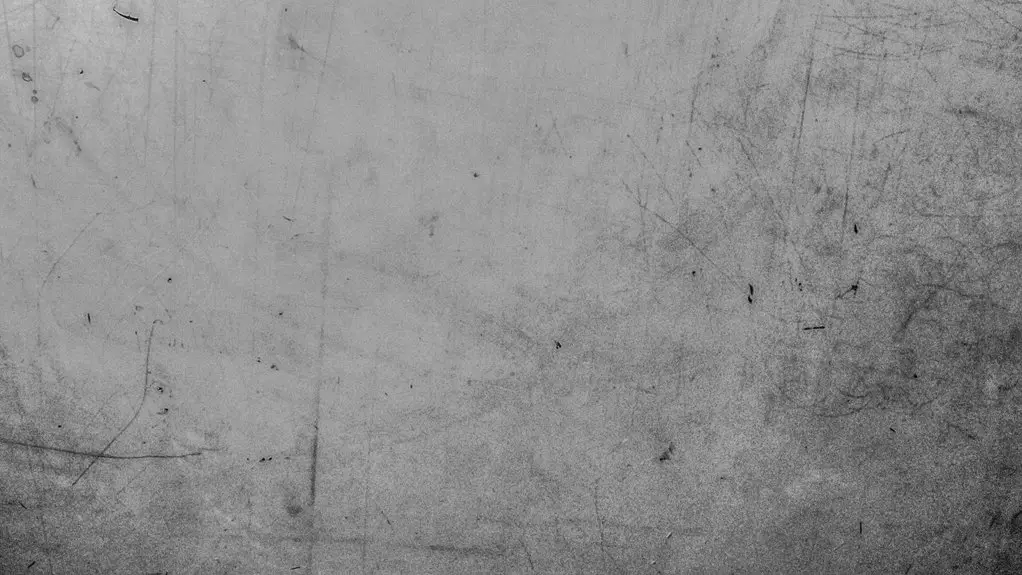To remove scuff marks and light scratches from leather, first identify your leather type, then gently clean the area with a soft cloth and mild soap or a leather cleaner. You can also use household remedies like a baking soda paste or white toothpaste applied softly, followed by wiping with a damp cloth. After cleaning, apply leather conditioner to restore moisture. These simple steps help maintain your leather’s appearance and durability—explore more ways to keep your leather looking its best.
Table of Contents
Key Takeaways
- Identify leather type to choose safe cleaning methods and avoid damage.
- Use a soft microfiber cloth with mild leather cleaner or homemade baking soda paste to gently remove scuff marks.
- Test any cleaner on a hidden spot before applying to visible areas.
- Apply leather conditioner after cleaning to restore moisture and flexibility.
- Regularly clean and condition leather to prevent scuffs and maintain appearance.
Identifying the Type of Leather
How can you effectively remove scuff marks without knowing your leather’s type?
First, take a close look and feel the surface. Smooth, shiny leather is usually finished or coated, while suede and nubuck have a soft, fuzzy texture. Genuine leather often has natural grain patterns and slight imperfections, unlike synthetic leather, which feels more plastic-like.
Examine your leather closely: smooth and shiny means coated, fuzzy indicates suede or nubuck, and plastic-like often signals synthetic.
Check labels or tags if you have them, as they often specify leather type. Knowing whether your leather is aniline, semi-aniline, or pigmented also guides your cleaning approach. For instance, aniline is more delicate and absorbs liquids quickly, so you need gentler methods.
Identifying your leather type guarantees you choose the safest way to remove scuff marks without damaging the material. Take your time here—this step sets the foundation for effective cleaning.
Gathering Necessary Materials
To tackle scuff marks on leather effectively, you’ll need a few essential materials ready. Gather a soft, clean microfiber cloth to avoid further scratching the surface.
Have a mild leather cleaner or a gentle soap solution on hand, but don’t use harsh chemicals. You’ll also want a leather conditioner to restore moisture after treatment. For light scratches, a leather repair balm or cream matching your leather’s color can be useful.
Keep cotton swabs or soft-bristled brushes nearby for precise application in small areas. Finally, have a bowl of lukewarm water for dampening your cloth, but avoid soaking the leather.
With these materials prepared, you’re set to address minor scuffs carefully and effectively.
Cleaning the Leather Surface
Start by gently dusting and wiping the leather to remove surface dirt.
Choose a mild cleaner designed for leather to avoid damage.
Always test the cleaner on a hidden spot before applying it to the visible area.
Dusting and Wiping
A gentle dusting is crucial before tackling any scuff marks on leather. You want to remove surface dirt and dust that could scratch the leather further when you wipe it.
Start by grabbing a soft, dry cloth or a microfiber duster to gently sweep away loose particles. Next, lightly dampen a clean cloth with water—never soak it—and wipe the leather in smooth, circular motions. This prepares the surface without causing damage.
Keep these tips in mind:
- Use a separate cloth for drying to avoid excess moisture.
- Avoid harsh scrubbing, which can wear down the leather.
- Work in small sections to guarantee thorough cleaning.
Choosing Gentle Cleaners
Selecting the right cleaner can make all the difference when treating scuff marks on leather. You want to pick gentle cleaners that won’t strip the leather’s natural oils or damage its finish. Avoid harsh chemicals like bleach, ammonia, or anything acidic.
Instead, opt for mild soap solutions or products specifically designed for leather care. A mixture of warm water and a few drops of gentle dish soap often works well. Use a soft cloth dampened with your chosen cleaner to gently wipe the scuffed area.
Don’t soak the leather—too much moisture can cause damage. Remember, a gentle touch combined with the right cleaner helps preserve your leather’s texture and appearance while effectively lifting scuff marks.
Testing on Hidden Area
Before applying any cleaner to the visible leather surface, test it on a hidden spot first. This step guarantees the cleaner won’t discolor or damage your leather.
Choose an inconspicuous area, like under a cushion or inside a seam, to try out the product. Here’s what you should do:
- Apply a small amount of cleaner with a soft cloth.
- Wait 10-15 minutes to observe any changes in color or texture.
- Check for signs of damage such as fading, cracking, or stiffness.
If the leather remains unaffected, you can confidently clean the visible areas.
If you notice any negative effects, switch to a gentler product or consult a professional. Testing first helps protect your leather’s appearance and longevity.
Using a Leather Conditioner
You’ll find that using a leather conditioner not only helps remove scuff marks but also restores moisture and flexibility to the leather.
After you’ve cleaned the surface, apply a small amount of conditioner to a soft cloth. Gently rub it into the leather using circular motions, focusing on the scuffed areas. This helps to nourish the leather and reduce the appearance of minor scratches.
Apply conditioner with a soft cloth in circular motions to nourish leather and minimize scuffs.
Let the conditioner absorb fully, usually about 10 to 15 minutes, then buff the surface lightly with a clean cloth to bring out its natural shine.
Regular conditioning prevents leather from drying out and cracking, keeping it supple and resistant to future marks. Avoid over-applying; too much conditioner can leave a sticky residue.
Applying Mild Soap Solutions
You’ll want to pick a gentle soap that won’t damage your leather.
Using a soft cloth, apply the solution carefully to avoid soaking the material.
This approach helps lift scuff marks without harming the surface.
Choosing the Right Soap
Choosing the right soap is essential when removing scuff marks from leather because harsh cleaners can damage the material.
You want to use a mild soap that cleans effectively without stripping the leather’s natural oils. Avoid anything with strong chemicals, abrasives, or alcohol. Instead, look for gentle options that maintain the leather’s softness and appearance.
Here are some good choices to evaluate:
- Saddle soap: Specifically designed for leather, it cleans and conditions simultaneously.
- Mild liquid hand soap: A gentle, readily available option if diluted properly.
- Castile soap: A natural, vegetable-based soap that’s safe and effective.
Proper Cleaning Techniques
Start by dampening a soft cloth with your mild soap solution, making sure it’s not too wet to avoid soaking the leather.
Gently wipe the scuffed area using small, circular motions. This helps lift dirt and scuff marks without damaging the leather’s surface.
Don’t scrub hard; leather is delicate and can scratch further if handled roughly.
After cleaning, use a clean, damp cloth to remove any soap residue.
Then, pat the area dry with a soft towel.
Avoid using excessive water or harsh chemicals, as they can dry out or discolor the leather.
Once dry, consider applying a leather conditioner to restore moisture and flexibility.
Following these steps guarantees you clean your leather properly while minimizing damage and extending its lifespan.
Utilizing Household Remedies
Although commercial leather cleaners are effective, many household remedies can quickly erase scuff marks without harsh chemicals. You might find these simple items around your home just as useful.
Many household remedies can quickly erase leather scuff marks without harsh chemicals, using items you likely already have.
For instance:
- White vinegar: Dampen a soft cloth with a mix of equal parts vinegar and water, gently rubbing the scuff to lift marks.
- Baking soda: Make a paste with water, apply it to the scuff, let it sit briefly, then wipe off with a clean cloth.
- Toothpaste: Use a non-gel, white toothpaste on a soft cloth to lightly buff the mark, then wipe with a damp cloth.
Always test these remedies on a hidden spot first. These options offer gentle yet effective ways to refresh your leather without risking damage.
Polishing and Buffing Techniques
After removing scuff marks with household remedies, you’ll want to restore the leather’s natural shine and texture. Start by applying a small amount of leather polish or conditioner using a soft cloth. Use circular motions to evenly spread the product, guaranteeing it penetrates the surface. Once applied, buff the leather gently with a clean microfiber cloth to enhance its luster without damaging the material.
| Step | Tool Needed | Purpose |
|---|---|---|
| Apply Polish | Soft cloth | Restore moisture and shine |
| Spread Evenly | Circular motions | Guarantee full coverage |
| Buff Surface | Microfiber cloth | Enhance leather’s natural glow |
| Repeat If Needed | Leather conditioner | Maintain softness and protection |
Preventative Care Tips for Leather
To keep your leather looking its best and prevent future scuff marks, you need to adopt regular preventative care habits. Consistent maintenance not only preserves the leather’s appearance but also extends its lifespan.
Here are some essential tips to help you protect your leather items:
- Store leather away from direct sunlight and heat sources to prevent drying and cracking.
- Clean your leather regularly with a soft, damp cloth and use a suitable leather conditioner every few months to maintain its suppleness.
- Avoid placing sharp or rough objects near your leather to minimize accidental scratches and scuffs.
Frequently Asked Questions
Can Colored Leather Markers Fix Deep Scratches?
You can use colored leather markers to improve deep scratches, but they won’t fully fix them. Markers help blend the color, but deep damage usually needs professional repair or leather filler for the best results.
Is It Safe to Use Shoe Polish on Leather Furniture?
You can use shoe polish on leather furniture, but it’s not ideal. It might darken or damage the leather’s finish. Instead, choose a product specifically designed for leather to keep it safe and looking great.
How Do Humidity Levels Affect Leather Maintenance?
Think of leather as a living tree—too much humidity, and it swells; too little, and it cracks. You’ll want to keep your leather balanced, avoiding extremes to maintain its supple, lasting beauty.
Can Leather Repair Kits Restore Torn Leather?
You can use leather repair kits to restore torn leather, especially small tears or cracks. They contain patches, adhesives, and color compounds to fix damage, but larger tears might need professional repair for best results.
Are There Professional Services for Leather Restoration?
Yes, you can find professional leather restoration services that specialize in repairing scratches, scuffs, and tears. They’ll assess your leather’s condition and use expert techniques to restore its appearance, saving you time and effort.
- Is Silk a Nonwoven Fabric? - July 11, 2025
- Is Cotton Typically Woven or Nonwoven? - July 11, 2025
- Is Chenille a Woven or Nonwoven Fabric? - July 11, 2025







